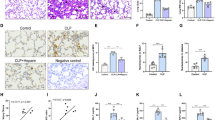Abstract
Addition of cultured and then carefully-washed bovine pulmonary artery endothelial cells (EC) decreased (p < 0.05) human neutrophil elastase activity (HNE) in vitro. HNE activity was also decreased (p < 0.05) by addition of histone or protamine treated EC. However, addition of papain or trypsin treated EC decreased HNE activity less than addition of untreated cells suggesting that a protein rather than a difference in cell surface charge was responsible. Other observations suggest that EC anti-elastolytic activity was not due to binding of antiprotease from culture media but was dependent on EC protein synthesis. First, addition of EC grown previously in serum-free media decreased HNE activity the same (p < 0.05) as addition of EC cultured in media containing serum. Second, addition of EC treated beforehand with cycloheximide decreased HNE activity less than (p < 0.05) addition of untreated control EC. We conclude that EC most likely make and have antielastolytic activity on their surfaces and speculate that EC associated anti-elastolytic activity may modulate inflammatory, repair and other biologic processes involving neutrophil elastase.
Similar content being viewed by others
References
Janoff, A. 1985. Elastases and emphysema: current assessment of the protease-antiprotease hypothesis.Am. Rev. Respir. Dis. 132:417–433.
Carp, H., andA. Janoff. 1978. Possible mechanisms of emphysema in smokers. In vitro suppression of serum-inhibitory capacity by fresh cigarette smoke and its prevention by antioxidants.Am. Rev. Respir. Dis. 118:617–621.
Abboud, R. T., T. Fera, A. Richter, M. Z. Tabona, andS. Johal. 1985. Acute effect of smoking on the functional activity of alpha1-protease inhibitor in bronchoalveolar lavage fluid.Am. Rev. Respir. Dis. 131:79–85.
Carp, H., F. Miller, J. R. Hoidal, andA. Janoff. 1982. Alpha1-proteinase inhibitor purified from lungs of cigarette smokers contains oxidized methionine and has decreased elastase inhibitory capacity.Proc. Natl. Acad. Sci. USA 79:2041–2045.
Laurell, C. B., andS. Eriksson. 1963. The electrophoretic alpha1-globulin pattern of serum in alpha1-antitrypsin deficiency.Scand. J. Clin. and Lab. Invest. 15:132–140.
Abrams, W. R., A. B. Cohen, V. V. Damiano, A. Eliraz, P. Kimbel, D. R. Meranze, andG. Weinbaum. 1981. A model of decreased functional alpha-1-proteinase inhibitor. Pulmonary pathology of dogs exposed to chloramine T.J. Clin. Invest. 68:1132–1139.
Abrams, W. R., A. Eliraz, P. Kimbel, andG. Weinbaum. 1980. The effect of the oxidizing agent chloramine T and cigarette smoke on dog serum proteinase inhibitors.Exp. Lung Res. 1:211–223.
Bachofen, M., andE. R. Weibel. 1977. Alterations of the gas exchange apparatus in adult respiratory insufficiency associated with septicemia.Am. Rev. Respir. Dis. 116:589–615.
Weiland, J. E., W. B. Davis, J. R. Holter, J. R. Mohammed, P. M. Dorinsky, andJ. E. Gadek. 1986. Lung neutrophils in the adult respiratory distress syndrome: Clinical and pathophysiologic significance.Am. Rev. Respir. Dis. 133:218–225.
Cochrane, C. G., R. Spragg, andS. D. Revak. 1983. Pathogenesis of the adult respiratory distress syndrome: evidence of oxidant activity in bronchoalveolar lavage fluid.J. Clin. Invest. 71:754–758.
McGuire, W. W., R. G. Spragg, A. B. Cohen, andC. G. Cochrane. 1982. Studies on the pathogenesis of the adult respiratory distress syndrome.J. Clin. Invest. 69:543–553.
Zheutlin, L. M., E. J. Thonar, S. Gillespie, E. R. Jacobs, M. E. Hanley, R. A. Balk, andR. C. Bone. 1987. C3a DES ARG and elastase alpha-1-protease inhibitor levels in lavage fluid from patients with adult respiratory distress syndrome.J. Crit. Care 2:86–92.
Baird, B. R., J. C. Cheronis, R. A. Sandhaus, E. M. Berger, C. W. White, andJ. E. Repine. 1986. O2 metabolites and neutrophil elastase synergistically cause edematous injury in isolated rat lungs.J. Appl. Physiol. 61:2224–2229.
Rodell, T. C., J. C. Cheronis, C. L. Ohnemus, D. J. Piermattei, andJ. E. Repine. 1987. Xanthine oxidase mediates elastase-induced injury to isolated lungs and endothelium.J. Appl. Physiol. 63:2159–2163.
Bowman, C. M., E. N. Butler, andJ. E. Repine. 1983. Hyperoxia damages cultured endothelial cells causing increased neutrophil adherance.Am. Rev. Respir. Dis. 128:469–472.
Bieth, J., B. Spiess, andC. G. Wermuth. 1974. The synthesis and analytic use of a highly sensitive and convenient substrate for elastase.Bioch. Med. 11:350–357.
Carp, H., andA. Janoff. 1980. Potential mediators of inflammation. Phagocytic-derived oxidants suppress the elastase inhibitory capacity of alpha-1-protease inhibitor in vitro.J. Clin. Invest. 66:987–995.
Nagy, Z., H. Peters, andI. Huttner. 1983. Charge-related alterations of the cerebral endothelium.Lab. Invest. 49:662–671.
Carlson, J. A., B. B. Rogers, R. N. Sifers, H. K. Hawkins, M. J. Finegold, andS. L. Woo. 1988. Multiple tissues express alpha-1-antitrypsin in transgenic mice and man.J. Clin. Invest. 82:26–36.
Dziegielewska, K. M., N. R. Saunders, E. J. Schetjer, H. Zakut, D. Zevin-Jonkin, R. Zisling, andH. Sorez. 1986. Synthesis of plasma proteins in fetal, adult, and neoplastic human brain tissue.Dev. Biol. 115:93–104.
Geboes, F., M. B. Ray, P. Rutgeerts, F. Callea, V. J. Desmet, andG. Vantrappen. 1982. Morphologic identification of alpha-1-antitrypsin in human cell intestine.Histopathology (Oxf)6:55–60.
Kittas, C., K. Aroni, A. Mantani, andC. S. Papadimitriou. 1982. Immunocytochemical demonstration of alpha-1-antitrypsin and alpha-1-antichymotrypsin in human gastrointestinal tract.Hepatogastroenterology 29:275–277.
Ray, M. B., V. J. Desmet, andW. Gepts. 1977. Alpha-1-antitrypsin immunoreactivity in islet cells of human pancreas.Cell Tissue Res. 185:63–68.
Tahara, E., H. Ito, K. Taniyama, H. Yokozaki, andJ. Hata. 1984. Alpha-1-antitrypsin, alpha-antichymotrypsin, and alpha-2-macroglobulin in human gastric carcinomas: a restrospec- tive immunohistochemical study.Human Pathology 15:957–964.
Mornex, J. F., A. Chytil-Weir, Y. Martinet, M. Courtney, J. P. LeCocq, andR. G. Crystal. 1986. Expression of the alpha-1-antitrypsin gene in mononuclear phagocytes of normal and alpha-1-antitrypsin-deficient individuals.J. Clin. Invest. 77:1952–1961.
Perlmutter, D. H., L. T. May, andP. B. Sehgal. 1989. Interferon B2/interleukin 6 modulates synthesis of α1-antitrypsin in human mononuclear phagocytes and in human hepatoma cells.J. Clin. Invest. 84:138–144.
Du Bois, R. M., J.-F. Bernaudin, P. Paako, R. Hubbard, H. Takahashi, U. Ferrans, andR. G. Crystal. 1991. Human neutrophils express the α-1-antitrypsin gene and produce α-1-antitrypsin.Blood 77:2724–2730.
Rao, C. N., D. E. Gomez, D. T. Woodley, andU. P. Thorgeirsson. 1995. Partial characterization of novel serine proteinase inhibitors from human umbilical vein endothelial cells.Arch. Biochem. and Biophys. 319:55–62.
Author information
Authors and Affiliations
Rights and permissions
About this article
Cite this article
Hanley, M.E., Terada, L.S., Cheronis, J.C. et al. Endothelial cell associated anti-elastolytic activity. Inflammation 20, 327–337 (1996). https://doi.org/10.1007/BF01488207
Issue Date:
DOI: https://doi.org/10.1007/BF01488207




